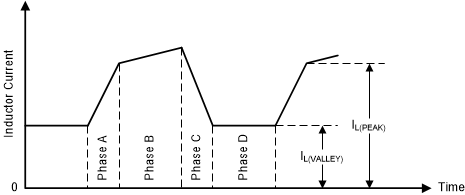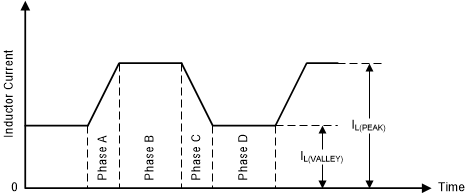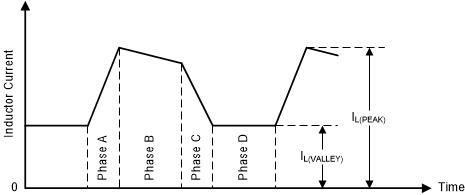JAJSLU5B December 2021 – August 2024 TPS63901
PRODUCTION DATA
- 1
- 1 特長
- 2 アプリケーション
- 3 概要
- 4 Pin Configuration and Functions
- 5 Specifications
-
6 Detailed Description
- 6.1 Overview
- 6.2 Functional Block Diagram
- 6.3 Feature Description
- 6.4 Device Functional Modes
- 7 Application and Implementation
- 8 Power Supply Recommendations
- 9 Layout
- 10Device and Documentation Support
- 11Revision History
- 12Mechanical, Packaging, and Orderable Information
6.3.1 Trapezoidal Current Control
Figure 6-1 shows a simplified block diagram of the power stage of the device. Inductor current is sensed in series with Q1 (the peak current) and Q4 (the valley current).
 Figure 6-1 Power Stage Simplified Block Diagram
Figure 6-1 Power Stage Simplified Block DiagramThe device uses a trapezoidal inductor current to regulate its output under all operating conditions. Thus, the device only has one operating mode and does not display any of the mode-change transients or unpredictable switching displayed by many other buck-boost devices.
There are four phases of operation:
- Phase A – Q1 and Q3 are on and Q2 and Q4 are off.
- Phase B – Q1 and Q4 are on and Q2 and Q3 are off.
- Phase C – Q2 and Q4 are on and Q1 and Q3 are off.
- Phase D – Q2 and Q3 are on and Q1 and Q4 are off.
Figure 6-2 shows the inductor current waveform when VI > VO, Figure 6-3 shows the current waveform when VI = VO, and Figure 6-4 shows the current waveform when VI < VO.
Figure 6-2 through Figure 6-4 show the typical waveforms during continuous conduction mode (CCM) switching for three operating conditions. During discontinuous conduction mode (DCM), the typical inductor current waveforms look similar to CCM with Phase D at 0-A inductor current. In deep boost mode, where VI << VO, Phase C length gradually decreases to zero until the switching waveform becomes triangular.
 Figure 6-2 Inductor Current Waveform when VI > VO (CCM)
Figure 6-2 Inductor Current Waveform when VI > VO (CCM) Figure 6-3 Inductor Current Waveform when VI = VO (CCM)
Figure 6-3 Inductor Current Waveform when VI = VO (CCM) Figure 6-4 Inductor Current Waveform when VI < VO (CCM)
Figure 6-4 Inductor Current Waveform when VI < VO (CCM)The ideal relationship between VI and VO (that is, assuming no losses) is:

where
- VI is the input voltage.
- VO is the output voltage.
- tw(A) is the duration of phase A.
- tw(B) is the duration of phase B.
- tw(C) is the duration of phase C.
By varying relative duration of each phase, the device can regulate VO to be less than, equal to, or greater than VI.